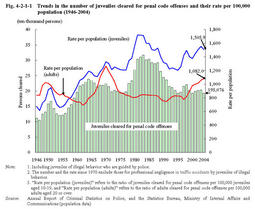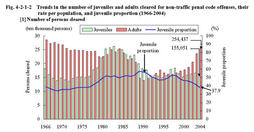| Previous Next Index Image Index Year Selection | |
|
|
1 Trends in number of juveniles cleared Fig.4-2-1-1 shows the number of juveniles cleared for penal code offenses(including juveniles of illegal behavior who are guided by police,hereinafter the same in this subsection),their rates per100,000juveniles aged10-19,and adults cleared for penal code offenses per100,000adults aged20or over since1946(see Appendix4-1 ).
Fig.4-2-1-1 Trends in the number of juveniles cleared for penal code offenses and their rate per100,000population(1946-2004) The number of juveniles cleared for penal code offenses had three peaks,in1951at166,433,in1964at238,830,and in1983at317,438.The first peak was the trend between1945and1954when the economy and society were in chaos after the war and the chaotic situation gradually settled down,the second was the trend between1955and1974when society enjoyed high economic growth,and the third was the trend in the rich society era after1975.The population of juveniles aged10-19has been on a declining trend after hitting a peak in1986.The number of juveniles cleared also decreased accordingly,and fell to below200,000in1995.The number has remained around200,000ever since,except exceeding220,000in1998,and was193,076in2004(down by5.2%from the previous year). The rate of juveniles cleared per population showed a similar trend in their number,having three peaks,in1951at948.6,in1964at1,190.4,and in1981at1,721.7.After those peaks,the rate gradually decreased to1,205.5in1995,but then turned to increase again,reaching1,552.9in2003.In2004,it decreased by47.0points from the previous year to1,505.9,but has remained at a high level,following the third peak in around1983. Fig.4-2-1-2[1] shows the number of juveniles and adults cleared for non-traffic penal code offenses as well as the juvenile proportion to the total persons cleared since1966. Fig.4-2-1-2[2] shows the rate of juveniles and adults cleared for non-traffic penal code offenses per population since1966. The number of juveniles cleared for non-traffic penal code offenses,like the number of those cleared for penal code offenses,formed a big wave with a peak in1983at261,634.After some fluctuation,it has been around160,000in recent years,standing at155,051(down by6.6%from the previous year)in2004. The juvenile proportion to persons cleared was in the30%-range until1977,but increased gradually,exceeding50%in1981.The number of juveniles cleared exceeded that of adults cleared until1992,and the juvenile proportion reached57.4%in1989.However in recent years,the proportion has been on the decline due to an increase of adults cleared,except temporarily exceeding50%in1997and1998,and stood at37.9%in2004(down by3.5points from the previous year). In contrast,the rate of juveniles cleared for non-traffic penal code offenses per population,which hit a peak at1,432.2in1981,decreased until1992(892.0)but has been on an upward trend ever since.It reached1,265.4in2003but decreased by56.1points to1,209.3in2004,also remaining at a high level following the third peak. The rate of juveniles cleared for non-traffic penal code offenses per population is much higher than that of adults,remaining five or six times higher in recent years. Fig.4-2-1-2 Trends in the number of juveniles and adults cleared for non-traffic penal code offenses,their rate per population,and juvenile proportion(1966-2004) |


